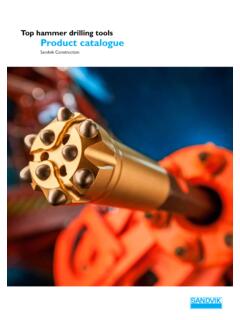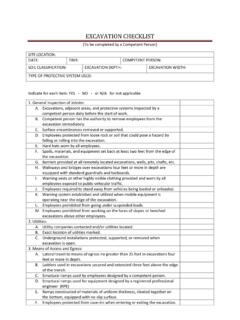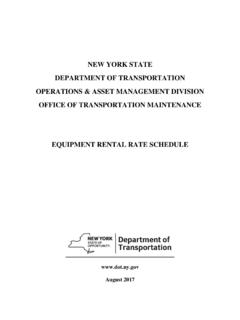Transcription of Surface Mining Methods and Equipment - EOLSS
1 UNESCO EOLSSSAMPLE CHAPTERSCIVIL ENGINEERING Vol. II - Surface Mining Methods and Equipment - J. Yamatomi and S. Okubo Encyclopedia of Life Support Systems ( EOLSS ) Surface Mining Methods AND Equipment J. Yamatomi and S. Okubo University of Tokyo, Japan Keywords: Mining method, Surface Mining , open pit Mining , open cast Mining , placer Mining , solution Mining , leaching, stripping ratio, Mining machinery, excavation, cutting, grading, loading, ditching Contents 1. Surface Mining Methods of Surface Mining Methods Open Pit vs. Underground Mining Methods Open Pit Mining Open Cast Mining Placer Mining Solution Mining 2. Surface Mining Machinery Glossary Bibliography Biographical Sketches Summary This chapter deals with Surface Mining . Section 1 presents an overview of Surface Mining Methods and practices as commonly employed in modern Surface Mining operations. The description includes a comparison of the advantages and disadvantages of Surface and underground Mining as well as brief explanations of open pit, open cast, placer, and solution Mining operations.
2 Section 2 describes Surface Mining Equipment with particular focus on relatively large machines such as bucket wheel excavators, large shovels and draglines. 1. Surface Mining Methods After a mineral deposit has been discovered, delineated, and evaluated, the most appropriate Mining method is selected based on technical, economic, and environmentally accountable considerations. The first step in selecting the most appropriate Mining method is to compare the economic efficiency of extraction of the deposit by Surface and underground Mining Methods . This section reviews Surface Mining Methods and practices. Classification of Surface Mining Methods Extraction of mineral or energy resources by operations exclusively involving personnel working on the Surface without provision of manned underground operations is referred to as Surface Mining . While an opening may sometimes be constructed below the Surface and limited underground development may occasionally be required, this type of Mining UNESCO EOLSSSAMPLE CHAPTERSCIVIL ENGINEERING Vol.
3 II - Surface Mining Methods and Equipment - J. Yamatomi and S. Okubo Encyclopedia of Life Support Systems ( EOLSS ) is essentially Surface -based. Surface Mining can be classified into two groups on the basis of the method of extraction; mechanical extraction, or aqueous extraction. Mechanical extraction Methods employ mechanical processes in a dry environment to recover minerals, encompassing the specific Mining Methods of: Open pit Mining Open cast Mining Quarrying of dimension stone Highwall/auger Mining Open pit and open cast Methods employ a conventional Mining cycle of operations to extract minerals: rock breakage is usually accomplished by drilling and blasting for consolidated materials and by ripping or direct removal by excavators for unconsolidated soil and/or decomposed rock, followed by materials handling and transportation. Dimension stone quarrying is quite similar to open pit Mining , but rock breakage without blasting is almost exclusively employed to cut prismatic blocks or tabular slabs of rock.
4 The high labor intensity and cost associated with cutting stone makes quarrying the most expensive Surface Mining method. Highwall Mining is a coal Mining method for recovery of outcropped coal by mechanical excavation without removal of overburden. A continuous miner with single or multiple augers/cutting heads is operated underground and controlled remotely by crew located outside. Augering can be regarded as a supplementary method for open cast Mining in cases when coal seams in the highwall would otherwise remain unmined (unless recoverable by underground Methods ) or when rugged terrain would preclude economic stripping by conventional Surface Methods . Quarrying of dimension stone and highwall Mining are specialized and less frequently used Methods , and will not be looked at in detail in this report. Aqueous extraction in most cases involves the use of water or a liquid solvent to flush minerals from underground deposits, either by hydraulic disintegration or physicochemical dissolution.
5 Aqueous extraction includes: Placer Mining Solution Mining Placer Mining is intended for the recovery of heavy minerals from alluvial or placer deposits, using water to excavate, transport, and/or concentrate minerals. Solution Mining is employed for extracting soluble or fusible minerals using water or a lixiviant. Open Pit vs. Underground Mining Methods While most mineral deposits can be mined by either Surface or underground Methods , some minerals can only be recovered in a hybrid manner, usually by initial extracted by open pit Mining , followed by underground Methods . Here, a brief comparison is made with respect to the advantages and disadvantages of various Mining Methods . Figures 1a and 1b show histograms of production sizes for metal mines operated during between 1988 and 1997 in the western world. Open pit Mining is the most common method for large-scale operations, whereas underground Mining is generally the most UNESCO EOLSSSAMPLE CHAPTERSCIVIL ENGINEERING Vol.
6 II - Surface Mining Methods and Equipment - J. Yamatomi and S. Okubo Encyclopedia of Life Support Systems ( EOLSS ) effective for small-scale operations. Most bauxite, iron, and copper ore is mined by open pit techniques, lead and zinc ore are principally extracted by underground Mining Methods , and precious metals, particularly gold and most notably in the USA and Australia, tend to be recovered in recent years from low-grade deposits by Surface Mining . Figure 1a. Production size distribution of metal mines for the period 1988 to 1997 in the western world Figure 1b. Processed ore by production rates for open pit and underground metal mines for the period 1988 to 1997 in the western world UNESCO EOLSSSAMPLE CHAPTERSCIVIL ENGINEERING Vol. II - Surface Mining Methods and Equipment - J. Yamatomi and S. Okubo Encyclopedia of Life Support Systems ( EOLSS ) Figure 1c. Processed ore by minerals for open pit and underground metal mines for the period 1988 to 1997 in the western world Larger mines offer higher productivity and lower operating costs than smaller mines.
7 Furthermore, open pit mines, typical of larger operations, have much higher normal productivity and lower unit operating costs than for comparable underground mines. However, the productivity and operating cost of an underground mine are heavily dependent on the Mining method employed, the rock conditions, the quality and economic value of the mineral, and the degree of automation/mechanization amongst other factors. Figure 2 shows a comparison of the annual production rates and productivities of US coal mines. Surface mines have very few limitations on the operation of large machines with high capacity, whereas underground operations are considerably restricted by narrow working spaces and rock conditions. Moreover, less commuting time is required at a Surface mine, whereas a much longer time is consumed by transportation in an underground mine because of the typically long distance from the mine entry to the working stope and face.
8 Thus, more net working hours are available at Surface mines, which results in higher production rates per employee. Therefore, production rates per employee for open pit mines are superior to those of underground mines. UNESCO EOLSSSAMPLE CHAPTERSCIVIL ENGINEERING Vol. II - Surface Mining Methods and Equipment - J. Yamatomi and S. Okubo Encyclopedia of Life Support Systems ( EOLSS ) Figure 2. Change in production and productivity of US coal mines The higher productivity for open pit Mining Equipment also lowers costs. The necessary underground Equipment for maintaining productivity is more expensive on a unit basis capacity than corresponding open pit Equipment . Furthermore, the large production scale and share number of open pit mines have provided the opportunity for manufacturing open pit Equipment in large numbers, thus reducing production costs even further. Open pit machinery can also be used for other purposes such as civil construction, whereas underground Mining Equipment is specialized and expensive.
9 A number of Surface mines operate 24 hours/day and almost 365 days/year in order to use open pit machinery for as many hours as possible, thereby reducing the number of machines required. In contrast, underground operations are often interrupted by the need for maintenance in addition to non-productive hours required for commuting and evacuation from blasting and explosives gases. Consequently, higher utilization of equipments and miners is usually difficult in underground mines, and higher capital per ton of ore is also required. Furthermore, it is not uncommon for underground miners to be paid more per hour than a worker doing a similar job on the Surface . For these reasons, in conjunction with the better productivity and time utilization of Surface operations, the labor cost per effective working hour in underground mines is much higher than on the Surface . Underground mines also require additional energy and expenditure for ventilation, air conditioning if required, transportation to the Surface , pumping, and lighting.
10 Surface Mining is generally considered to provide better recovery, grade control, flexibility, safety, and working environments than underground Mining . Figure 3 shows a comparison of the total injury rates in US coal mines. The injury rates have declined both in Surface and underground mines. However, the total number of injuries per one million employee-hours for underground US coal mines in the last decade is three to four times higher than for Surface mines. The difference between the injury rates per one million tons of coal production further demonstrates this point underground Mining is less favorable and accidents in underground mines tend to be more serious than for Surface UNESCO EOLSSSAMPLE CHAPTERSCIVIL ENGINEERING Vol. II - Surface Mining Methods and Equipment - J. Yamatomi and S. Okubo Encyclopedia of Life Support Systems ( EOLSS ) mines. From an environmental point of view, however, Surface mines normally cause extensive and more visible impacts on the surrounding landscapes than underground mines, primarily due to the huge amounts of waste and overburden dumped around the mines and the damage to scenery by the Surface operations themselves.















